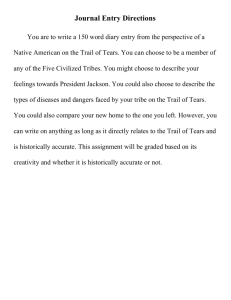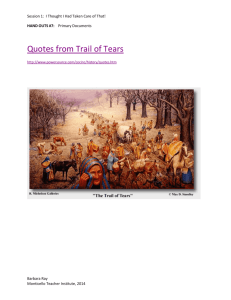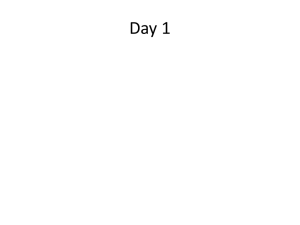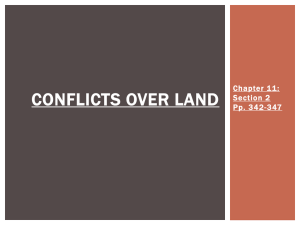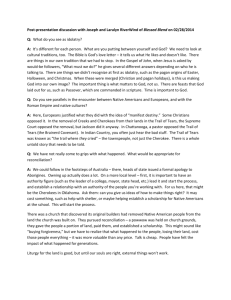Indian Removal Stations
advertisement
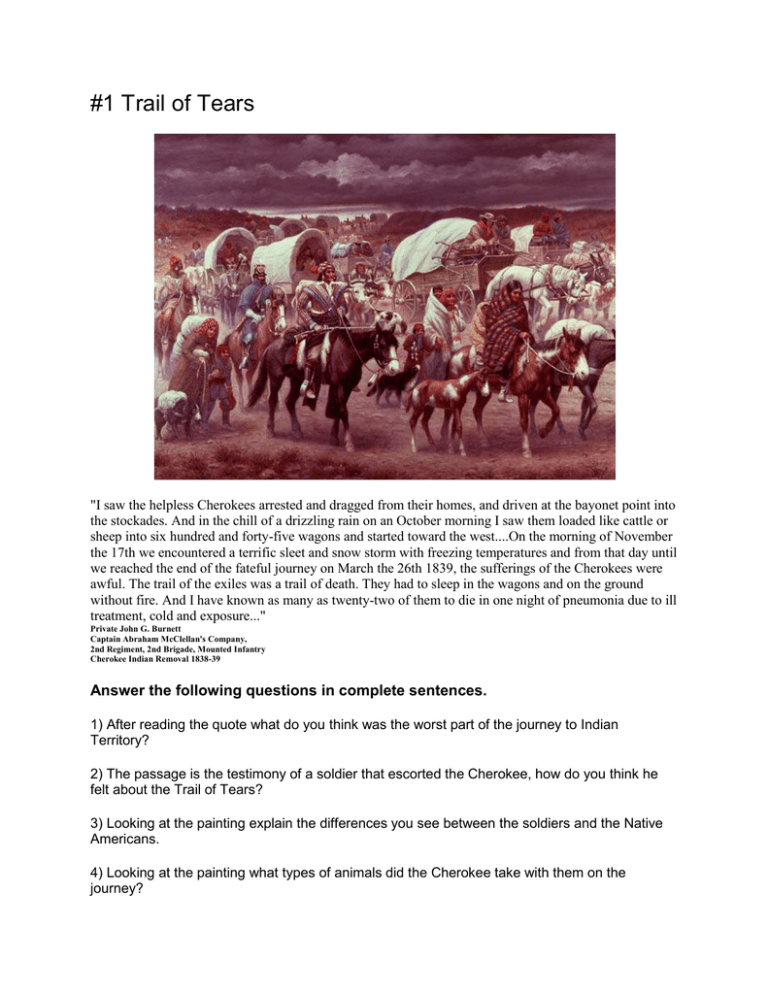
#1 Trail of Tears "I saw the helpless Cherokees arrested and dragged from their homes, and driven at the bayonet point into the stockades. And in the chill of a drizzling rain on an October morning I saw them loaded like cattle or sheep into six hundred and forty-five wagons and started toward the west....On the morning of November the 17th we encountered a terrific sleet and snow storm with freezing temperatures and from that day until we reached the end of the fateful journey on March the 26th 1839, the sufferings of the Cherokees were awful. The trail of the exiles was a trail of death. They had to sleep in the wagons and on the ground without fire. And I have known as many as twenty-two of them to die in one night of pneumonia due to ill treatment, cold and exposure..." Private John G. Burnett Captain Abraham McClellan's Company, 2nd Regiment, 2nd Brigade, Mounted Infantry Cherokee Indian Removal 1838-39 Answer the following questions in complete sentences. 1) After reading the quote what do you think was the worst part of the journey to Indian Territory? 2) The passage is the testimony of a soldier that escorted the Cherokee, how do you think he felt about the Trail of Tears? 3) Looking at the painting explain the differences you see between the soldiers and the Native Americans. 4) Looking at the painting what types of animals did the Cherokee take with them on the journey? #2 Map of the Trail of Tears Answer the following questions in complete sentences. 1) What Native American Tribe was the last to be removed from the south? 2) In what current state were reservations set up in for Native Americans? 3) How many miles did the Cherokee travel along the Trail of Tears? 4) Which Native American group traveled west by sea? #3 Assimilation In the late 1700’s, reformers including George Washington supported educating native children, in efforts to "civilize" or otherwise assimilate Native Americans to the larger society. The Civilization Fund Act of 1819 promoted this civilization policy by providing funding to societies (mostly religious) who worked on Native American improvement. “ I rejoice, brothers, to hear you propose to become cultivators of the earth for the maintenance of your families. Be assured you will support them better and with less labor, by raising stock and bread, and by spinning and weaving clothes, than by hunting. A little land cultivated, and a little labor, will procure more provisions than the most successful hunt; and a woman will clothe more by spinning and weaving, than a man by hunting. ” —President Thomas Jefferson, Brothers of the Choctaw Nation, December 17, 1803 After the American Civil War and Indian wars in the late 19th century, Native American boarding schools were established, which were often run primarily by or affiliated with Christian missionaries. At this time American society thought that Native American children needed to be acculturated to the general society. The boarding school experience often proved traumatic to Native American children, who were taken from their families, forbidden to speak their native languages, taught Christianity and denied the right to practice their native religions, and in numerous other ways forced to abandon their Native American identities and adopt American culture. There were many cases of abuse occurring at these schools. Answer the following questions in complete sentences. 1) What is assimilation? 2) What president first advocated Native American assimilation? 3) According to the Jefferson quote what did he believe were the benefits of assimilation? 4) What role did schools play in assimilation? #4 Poverty Today Answer the following questions in complete sentences. 1) The above data lists poverty percentages for what 3 years? 2) What was the poverty rate for Native Americans in 1989? 3) What racial group has the lowest poverty group over the 3 year period? 4) What other racial group has a similar poverty rate to Native Americans? 5) Explain how living on a reservation might lead to high rates of poverty? #5 Native American Lands Today Answer the following questions in complete sentences. 1) Oklahoma was once known as Indian Territory, is the whole state still Reservations? 2) Are most Indian Reservations in the East or West of the nation? 3) Which state has the largest amount of reservation land? 4) Native Americans once controlled the whole nation how do you think the loss of their land has changed their culture?

